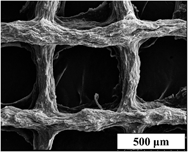Crossref Citations
This article has been cited by the following publications. This list is generated based on data provided by
Crossref.
Guo, Jason L.
Kim, Yu Seon
and
Mikos, Antonios G.
2019.
Biomacromolecules for Tissue Engineering: Emerging Biomimetic Strategies.
Biomacromolecules,
Vol. 20,
Issue. 8,
p.
2904.
Pahlevanzadeh, Farnoosh
Emadi, Rahmatollah
Valiani, Ali
Kharaziha, Mahshid
Poursamar, S. Ali
Bakhsheshi-Rad, Hamid Reza
Ismail, Ahmad Fauzi
RamaKrishna, Seeram
and
Berto, Filippo
2020.
Three-Dimensional Printing Constructs Based on the Chitosan for Tissue Regeneration: State of the Art, Developing Directions and Prospect Trends.
Materials,
Vol. 13,
Issue. 11,
p.
2663.
Lee, Chung‐Sung
Hwang, Hee Sook
Kim, Soyon
Fan, Jiabing
Aghaloo, Tara
and
Lee, Min
2020.
Inspired by Nature: Facile Design of Nanoclay–Organic Hydrogel Bone Sealant with Multifunctional Properties for Robust Bone Regeneration.
Advanced Functional Materials,
Vol. 30,
Issue. 43,
Lee, Mihyun
Rizzo, Riccardo
Surman, František
and
Zenobi-Wong, Marcy
2020.
Guiding Lights: Tissue Bioprinting Using Photoactivated Materials.
Chemical Reviews,
Vol. 120,
Issue. 19,
p.
10950.
Lim, Khoon S.
Galarraga, Jonathan H.
Cui, Xiaolin
Lindberg, Gabriella C. J.
Burdick, Jason A.
and
Woodfield, Tim B. F.
2020.
Fundamentals and Applications of Photo-Cross-Linking in Bioprinting.
Chemical Reviews,
Vol. 120,
Issue. 19,
p.
10662.
Zheng, Xiao
Zhang, Xiaorong
Wang, Yingting
Liu, Yangxi
Pan, Yining
Li, Yijia
Ji, Man
Zhao, Xueqin
Huang, Shengbin
and
Yao, Qingqing
2021.
Hypoxia-mimicking 3D bioglass-nanoclay scaffolds promote endogenous bone regeneration.
Bioactive Materials,
Vol. 6,
Issue. 10,
p.
3485.
dos Santos, Juliana
de Oliveira, Rafaela S.
de Oliveira, Thayse V.
Velho, Maiara C.
Konrad, Martina V.
da Silva, Guilherme S.
Deon, Monique
and
Beck, Ruy C. R.
2021.
3D Printing and Nanotechnology: A Multiscale Alliance in Personalized Medicine.
Advanced Functional Materials,
Vol. 31,
Issue. 16,
Vyavhare, Kimaya
Bagi, Sujay
Pichumani, Pradip Sairam
Sharma, Vibhu
and
Aswath, Pranesh B.
2021.
Chemical and physical properties of tribofilms formed by the interaction of ashless dithiophosphate anti‐wear additives.
Lubrication Science,
Vol. 33,
Issue. 4,
p.
188.
Li, Jinhua
and
Pumera, Martin
2021.
3D printing of functional microrobots.
Chemical Society Reviews,
Vol. 50,
Issue. 4,
p.
2794.
Murugan, Sesha Subramanian
Anil, Sukumaran
Sivakumar, Padmanaban
Shim, Min Suk
and
Venkatesan, Jayachandran
2021.
Chitosan for Biomaterials IV.
Vol. 288,
Issue. ,
p.
87.
Rastin, Hadi
Mansouri, Negar
Tung, Tran Thanh
Hassan, Kamrul
Mazinani, Arash
Ramezanpour, Mahnaz
Yap, Pei Lay
Yu, Le
Vreugde, Sarah
and
Losic, Dusan
2021.
Converging 2D Nanomaterials and 3D Bioprinting Technology: State‐of‐the‐Art, Challenges, and Potential Outlook in Biomedical Applications.
Advanced Healthcare Materials,
Vol. 10,
Issue. 22,
Silva, Angelo Oliveira
Cunha, Ricardo Sousa
Hotza, Dachamir
and
Machado, Ricardo Antonio Francisco
2021.
Chitosan as a matrix of nanocomposites: A review on nanostructures, processes, properties, and applications.
Carbohydrate Polymers,
Vol. 272,
Issue. ,
p.
118472.
Guo, Zhongwei
Dong, Lina
Xia, Jingjing
Mi, Shengli
and
Sun, Wei
2021.
3D Printing Unique Nanoclay‐Incorporated Double‐Network Hydrogels for Construction of Complex Tissue Engineering Scaffolds.
Advanced Healthcare Materials,
Vol. 10,
Issue. 11,
Vyavhare, Kimaya
Sharma, Vibhu
Sharma, Vinay
Erdemir, Ali
and
Aswath, Pranesh B.
2021.
XANES Study of Tribofilm Formation With Low Phosphorus Additive Mixtures of Phosphonium Ionic Liquid and Borate Ester.
Frontiers in Mechanical Engineering,
Vol. 7,
Issue. ,
Vyavhare, Kimaya
Timmons, Richard B.
Erdemir, Ali
Edwards, Brian L.
and
Aswath, Pranesh B.
2021.
Tribochemistry of fluorinated ZnO nanoparticles and ZDDP lubricated interface and implications for enhanced anti-wear performance at boundary lubricated contacts.
Wear,
Vol. 474-475,
Issue. ,
p.
203717.
Awad, Kamal
Ahuja, Neelam
Fiedler, Matthew
Peper, Sara
Wang, Zhiying
Aswath, Pranesh
Brotto, Marco
and
Varanasi, Venu
2021.
Ionic Silicon Protects Oxidative Damage and Promotes Skeletal Muscle Cell Regeneration.
International Journal of Molecular Sciences,
Vol. 22,
Issue. 2,
p.
497.
Vyavhare, Kimaya
Timmons, Richard B.
Erdemir, Ali
Edwards, Brian L.
and
Aswath, Pranesh B.
2021.
Robust Interfacial Tribofilms by Borate- and Polymer-Coated ZnO Nanoparticles Leading to Improved Wear Protection under a Boundary Lubrication Regime.
Langmuir,
Vol. 37,
Issue. 5,
p.
1743.
Vyavhare, Kimaya
Timmons, Richard B.
Erdemir, Ali
and
Aswath, Pranesh B.
2021.
Tribological Interaction of Plasma-Functionalized CaCO3 Nanoparticles with Zinc and Ashless Dithiophosphate Additives.
Tribology Letters,
Vol. 69,
Issue. 2,
Arab‐Ahmadi, Samira
Irani, Shiva
Bakhshi, Hadi
Atyabi, Fatemeh
and
Ghalandari, Behafarid
2021.
Immobilization of carboxymethyl chitosan/laponite on polycaprolactone nanofibers as osteoinductive bone scaffolds.
Polymers for Advanced Technologies,
Vol. 32,
Issue. 2,
p.
755.
Yadav, L. Roshini
Chandran, S. Viji
Lavanya, K.
and
Selvamurugan, N.
2021.
Chitosan-based 3D-printed scaffolds for bone tissue engineering.
International Journal of Biological Macromolecules,
Vol. 183,
Issue. ,
p.
1925.
